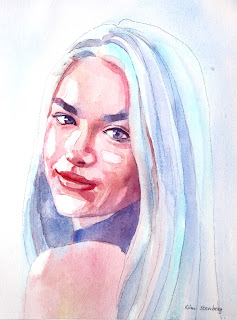 |
| "Red Amaryllis" |
The following is the description of what we did in the fifth week of the winter term, 2022 for my "Watercolor from Start to Finish" class (my online Zoom class with the Art League School in Alexandria, VA).
 |
| "Red Amaryllis" |
The following is the description of what we did in the fifth week of the winter term, 2022 for my "Watercolor from Start to Finish" class (my online Zoom class with the Art League School in Alexandria, VA).
 |
| "Winter Shadows" |
The following is the description of what we did in the fourth week of the winter term, 2022 for my "Watercolor from Start to Finish" class (my online Zoom class with the Art League School in Alexandria, VA).
 |
| "Blues and Mixing Dark Browns" |
 |
| "Mixing Oranges" |
 |
| "Portrait in Limited Palette" |
The following is what we did in the fourth week of the winter term, 2022 in my "Watercolor Portraits" class (my online Zoom classes with the Art League School in Alexandria, VA).
 |
| "Mixing Skin Tones" |
 |
| "Mixing Purples" |
 |
| "Step 1" |
 |
| "Step 2" |
 |
| "Step 3" |
 |
| "Crocuses in Snow" |
The following is the description of what we did in the third week of the winter term, 2022 for my "Watercolor from Start to Finish" class (my online Zoom class with the Art League School in Alexandria, VA).
 |
| "Yellow Swatches" |
 |
| "Mixing Purples" |
 |
| "My Parents" |
The following is what we did in the third week of the winter term,
2022 in my "Watercolor Portraits" class (my online Zoom classes with the Art League School in
Alexandria, VA). By the way, it was my birthday yesterday, and I thought it was quite appropriate to paint my dear parents, who had passed away (my father at the age of 43 and my mother almost 20 years ago). I painted them with gratitude and love. I hope they are pleased. My father, an architect, had wished to be an artist; I am living his dream thanks to the support of my family (including my mother, my mother-in-law and my husband). Thank you.
During the first half of the class, I discussed the properties of color: hue, value, intensity/chroma, and temperature, while making color swatches. I will keep repeating these important concepts, so if you are a little confused, don't worry about it! Please make your color swatches to become familiar with your paints.
 |
| "Snowman and Red Barn" |
 |
| "Swedish Girl" |
The following is what we did in the second week of the winter term, 2022 in my "Watercolor Portraits" class (my online Zoom classes with the Art League School in Alexandria, VA).
The main lesson of the day was painting a sepia value study of "Swedish Girl". We used only burnt sienna (my favorite is Daniel Smith) and cobalt blue. In the value scales, the value 10 is the white of the paper (highlights). The value 3 is as dark as it gets with the mixture of these two colors. The value 0 is black. The high-key paintings crowd around highlights and mid tones; the low-key paintings lack highlights and crowd around mid tones and darks. We won't be using ten values; you can do a convincing portrait with five or six values. Beginners' paintings often lack highlights and darks and remain in the mid-tone fest! |
| "Swedish Girl" Reference |